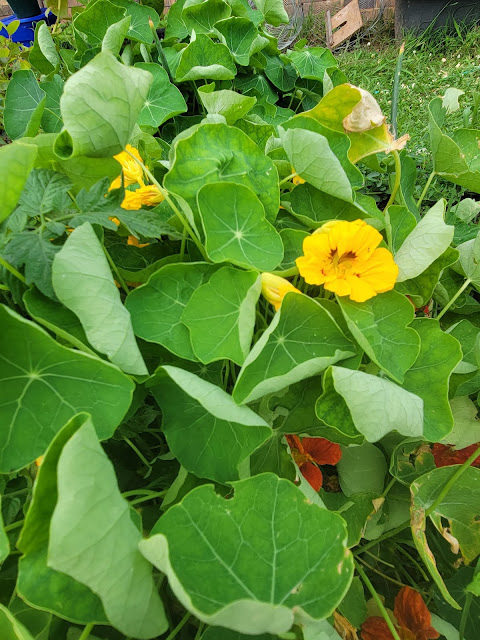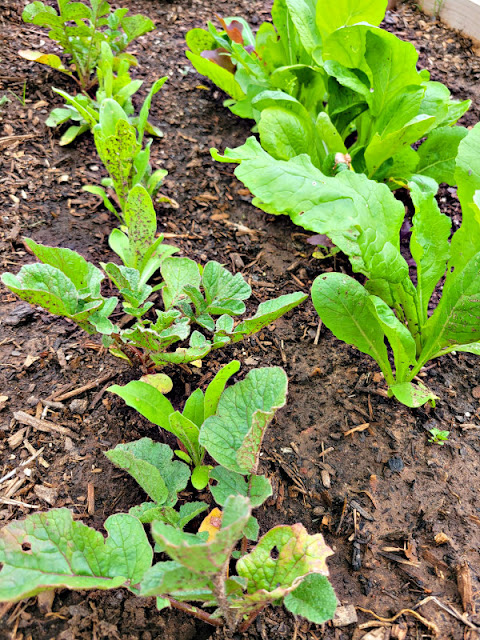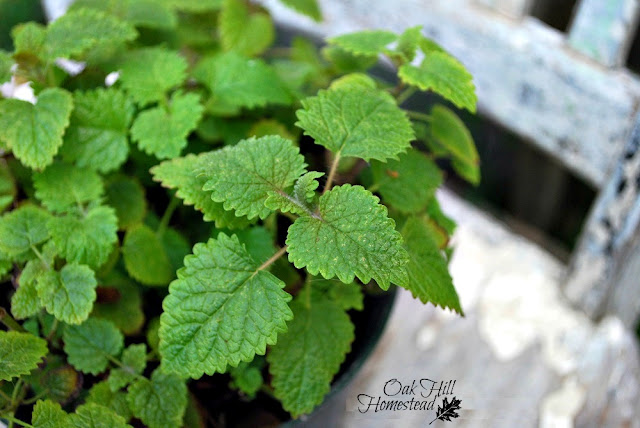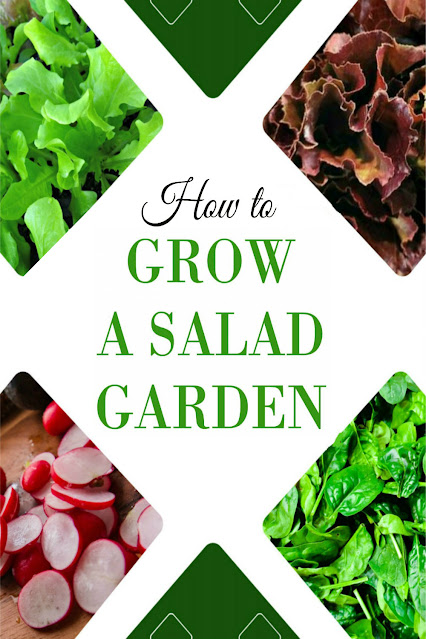Are you a salad lover? If you'd like to grow healthy salad greens and other salad plants - no matter the size of your garden - you'll learn how to grow a salad garden in this post. I've also included a list of the best salad garden plants to grow in a small space.
Keep reading for my eight secrets to growing a successful salad garden in a small space, a flowerbed or in plant pots and containers.
How to grow a salad garden in a small space
You can grow a healthy salad almost anywhere, even if you're short on garden space and have little gardening experience. Your best salad garden location might be right outside your door!
What is a "salad garden"?
A salad garden is where you grow the ingredients for delicious fresh salads.
In a large, traditional garden, you might see a row of lettuce here and a row of radishes over there with another row or bed that contains herb plants.
Just so you know, this post may contain affiliate links, which means I receive commissions for purchases made through those links, at no cost to you. You can read my disclosure policy for more info.
But if you don't have that much space, you can devote a small area - such as a flowerbed, one raised garden bed, or even a collection of plants growing in pots, planters and containers on your balcony or patio - to growing salad greens, radishes, cucumbers and other plants that are commonly added to salads.
You don't need (or want) to grow your plants in straight rows anyway. Growing several types of plants in a space (this is called interplanting or companion planting) will give you a healthier garden with fewer pests.
And think of all that wasted space between those garden rows! You can grow more plants in a small space by planting them closer together (intensive planting), and using succession planting (when you harvest one plant, grow another in its place) to maximize your space.
RELATED POST: Common terms and phrases for gardeners
It doesn't take much room to grow the ingredients for a flavorful salad.
Why grow a salad garden?
Imagine being able to walk out to your backyard, patio or deck and pick the ingredients for a salad, and walking back inside your home to prepare a fresh salad for lunch or dinner.
Eating a variety of fresh vegetables daily is important to our health, and what better way than to grow your own salad ingredients?
Growing your own salad greens and vegetables allows you to grow the healthiest food possible, without chemical pesticides and fertilizers.
My main reason for gardening is to avoid these toxic chemicals. Personally, I can't eat store-bought lettuce. It literally hurts my gut.
Lettuce is often contaminated with some of the most potent pesticides used on food, and is often treated with preservatives so it will last longer on the store shelves.
And how many times has lettuce been recalled by grocery stores because of food poisoning complaints?
You can avoid these chemicals and contaminants by growing lettuce yourself - and the other vegetables to go with it!
Color and variety are additional reasons to grow your own salad ingredients. Eating a variety of foods of different colors provides our bodies with the specific nutrients that are naturally found in each color.
Such a salad isn't only pleasing to our eyes, it's good for us!
Imagine a salad that’s made of both red and green lettuce leaves, spinach or microgreens, with some herbs, a sliced red tomato or a yellow pepper, topped with colorful flower petals and perhaps some alfalfa sprouts.
You’d pay a premium price for such a salad at a fancy restaurant.
How much space do you need?
The thing is, not everyone has enough outdoor space for a big garden. You might live in a townhome, an apartment, or a rented house where you can't till up the grass.
Or you might own a home with a small backyard.
But maybe your apartment has a balcony, or your townhouse or home has a patio. You can grow your salad plants in containers and even in a flowerbed.
Most plants are actually quite pretty as long as you maintain them and keep the containers or flowerbed weeded.
My favorite place to grow plants for salads is in my raised beds that are about eight inches deep, but honestly the salad plants are pretty much grown in one 4'x4' raised bed, so the space needed is minimal.
Of course, the more people you have in your family, the more space you may need, depending on how often you eat salad, how large your salads are and what plants you want to grow.
 |
| You can grow salad vegetables in just about anything that can hold dirt. This metal washtub contains several loose leaf lettuce plants plus onions. Holes in the bottom provide drainage. |
Growing vegetables in flowerbeds
If you plan to grow your salad plants in a flowerbed, you're pretty much ready to go!
If the bed is covered with wood mulch or rocks, you should rake that all off first.
If the ground underneath the mulch is really compacted (like concrete!) it will help to break it up at this point. You can do this with a shovel, a metal rake, a fork hoe, or whatever you have.
There's no need to dig it all up, or turn it over completely, or use a tiller. Just stick the shovel in the ground as far as you can to get some air into the soil.
I've found that the easiest way to dig in really compacted, hard soil is to wait until after a really good soaking rain!
Then add some bagged compost or soil to the flowerbed before planting. An inch or two or even more on top of the existing soil would be great.
Growing a salad in a raised bed
If you think about it, a raised bed is really a container, but without a bottom, set right on top of the dirt.
Just like a container, it should be filled with good soil and compost, and should drain well.
Learn more about building a raised garden bed here, or how to assemble a metal raised bed here.
Growing lettuce and other plants in containers
If all you have is a balcony or a patio, this is where the magic happens! Growing a salad garden in pots and containers on a balcony or patio is easy and it doesn't have to take up a lot of space.
You can use nearly anything that holds soil to grow plants. Just be sure it's sturdy, and that it has drain holes so the water can escape.
If you're drilling the holes in a container, locate them along the bottom edge of the sides, not necessarily on the bottom of the container. If you set it on top of concrete, for instance, water might not drain as easily from holes in the bottom.
Pots, buckets, flower boxes, grow bags, even hanging baskets can be used. A child's wading pool can hold a good-sized salad garden.
The secret to success
Choosing the right plants will help you grow a successful salad garden when you're limited on space. (You'll find more secrets to success further down in this article.)
The key is to grow small plants that produce well, and to grow a variety of colors, textures and flavors so you won’t be bored with your salads, even if you only have a small growing space.
Others will need to be grown from seeds, but it’s not hard. Here's how to start vegetables seeds indoors.
You don’t have to plant the whole packet of seeds! (That's another secret to growing a salad garden in a small space!)
Plant just a few seeds of each kind, even one or two, depending on how much space you have. Store the rest of the seed packet in a zippered freezer bag in the back of your refrigerator, where they won’t be affected by moisture.
Learn more about storing seeds so they'll germinate next year - and even the year after that!
Start by planting leafy greens. Since you'll be using these as the base of your salads, you'll need to plant more of these than other vegetables.
Then round out your salad garden with some fun and delicious veggies that will complement your salads.
The base of your salad
Leafy greens are usually the base of a salad, but there is so much variety to choose from: microgreens, spinach and the many kinds and varieties of loose leaf lettuce, just to name a few.
You can even grow those microgreens in your kitchen, any time of year.
Loose leaf lettuce is different from the head of iceberg lettuce that you buy at the grocery store. Head lettuce takes up more space in your garden, and when the plant is harvested, that's all you'll get.
But loose leaf lettuce is a much better choice for a small home garden. It's a "cut-and-come-again" type of plant. You can harvest the outer leaves as soon as they are large enough, and leave the rest of the plant to continue growing.
Spinach can be harvested in the same way. That "baby spinach" you buy at the grocery store is just young spinach leaves picked from the plants.
This is another of the space-saving secrets of a small salad garden: growing plants that continue to grow and produce over a period of time.
Lettuce is usually a cool-weather crop that doesn't grow well in hot weather, but there are several heat-tolerant lettuce varieties that have grown well for me here in Oklahoma, where the summer temperatures are over 100°F.
Grow a variety of loose leaf lettuce varieties in various colors and leaf shapes and textures to keep your salads interesting. I've included links to my favorite lettuce varieties at the end of this post.
Buy pre-packaged lettuce seed mixes which contain a variety of leaf colors, textures and lettuce alternatives such as arugula, chervil, endive, mâche, mustard greens, and so on. Every seed company packages their own selection of these seeds, sometimes called "mesclun."
You'll find my best tips on growing lettuce in your backyard garden here.
Root vegetables for salads
Radishes, beets, onions and so on are root vegetables, that is, the root is the part of the plant that we eat. These plants produce just one root per plant.
You might think they're space hogs, but you can eat the young leaves of radishes and beets as well as the radish itself. Experiment with them in your salad and see what you think.
Green onions are just onion plants that are picked early, before they form the bulb of the onion, and the tops can be eaten too. Because you pick them early, you can plant something else in that spot after you harvest them.
That's another secret to growing a salad garden in a small space: grow plants with more than one edible part.
And because you pick those green onions before they form an onion bulb, you can plant them closer together, so they don't take up as much space.
Tomatoes, cucumbers and peppers
These vegetables are often included in salads, but they do require more space and time to grow.
They usually need a trellis to grow on, to keep them from sprawling all over the ground and taking up a lot of room.
 |
| Cherry tomato plants, although they grow quite large, are very prolific. They begin to produce fruit much earlier than larger types of tomatoes such as beefsteaks. |
Bush cucumbers are a better choice for containers and small spaces. A vining variety of cucumber will need to be trellised or it will turn into a jungle!
Recently seed companies have been offering seeds for "micro tomato plants" that grow about one foot tall and produce lots of cherry tomatoes. These plants would be a much better use of limited space.
Be careful if you order micro tomato seeds though. Some of these plants will grow tomatoes that are the size of peas. Others, such as this one from Baker Creek Seeds, seem to be cherry tomato-sized.
If you prefer to buy transplants at the garden center instead of growing tomato plants from seeds, consider growing cherry tomatoes instead of the larger types. Cherry tomatoes usually mature faster than larger tomatoes, and the plants are usually very prolific.
Cherry tomatoes are smaller, of course, but can be eaten whole or cut in half to top a salad. Just know that even though the tomatoes themselves are small, these plants are still full-sized.
On the whole, look for plant varieties with names such as "dwarf," "mini," "compact" and "patio" for plants that will be a more manageable size if your space is limited.
Fun "garnish" plants
Now for the gourmet salad ingredients! These are the extras that make your salad pretty, add flavor, and elevate your salads from ho-hum-ordinary to extraordinary.
You can add herbs, flower petals, sprouts and more to your salads. And surprise! They are easy to grow.
A few small basil leaves will really change up the flavor of your salad. Basil plants can grow quite large, but if you keep them pruned they stay a manageable size. And it's no trouble to keep them pruned, because you're eating those leaves.
Garlic chives and onion chives are small, perennial plants that can add the flavor of garlic or chives. even mint leaves or lemon balm leaves are a tasty addition and super-easy to grow.
Sweet peas and snow peas are another great addition to salads. Let the plants trail over the side of your planters or containers, or grow them on a short trellis. The pea pods themselves can be eaten whole when they're young and tender.
Where to locate your salad garden
Most vegetable plants appreciate full sun, which simply means a location where they will receive 6-8 hours of sunlight each day. Tomato and pepper plants require a lot of sunshine.
But many of the plants that are eaten in salads can tolerate some shade and partial sun - such as lettuce, spinach and root vegetables.
If you grow a plant for its leaves and/or root, they can be planted in partial shade. Plants that you grow for their fruit, such as tomatoes, peppers and cucumbers, need more sun.
Growing in containers and planters can be an advantage! You can move them from place to place to take advantage of the sun's path during the growing season.
For instance, you might have a sunny spot during the spring but as the sun moves with the seasons, that location might not receive as much sunshine in the summer due to shadows from buildings, trees or fences.
My ebook How to Grow Vegetables and Herbs in a Shady Garden goes into more detail on this topic, and gives you tips for boosting the light you have available too.
Watering and fertilizing your plants
You'll need to keep an eye on your salad garden and water when necessary. Be sure to locate your garden near a water source or within reach of a hose.
The general rule is that plants need about an inch of water per week, whether it's rainfall or from a hose.
Plants that are growing in containers will need to be watered more often.
For more tips on watering your garden, check out How to Make Watering Your Vegetable Garden Easier.
The secrets to growing a salad garden in a small space
We've talked about a couple salad garden secrets already:
- Growing the right plants, such as loose leaf lettuce instead of head lettuce, that will grow and continue to produce over time. A head of lettuce must be harvested and used, while cut-and-come-again plants can be harvested leaf by leaf and will continue growing for a longer harvest.
- You don't have to plant the whole packet of seeds. Plant what you need and save the rest. Here's how to store your leftover seeds.
- Grow plants with more than one edible part, such as beets and radishes. Nasturtiums are another double-duty plant: the young leaves, flower petals and seed pods are all edible and delicious. They also help control insect pests in your garden, and they attract pollinators.
- Plant a variety of colors, textures and flavors, such as various colors of lettuce, plus spinach and microgreens, plus herbs, edible flowers and sprouts.
Here are a few more tips to make the most of the space you have available.
5. Plant cool-weather crops early in the spring.
Most of them can handle a light frost, and planting early will give you an earlier harvest.
When the weather warms up and most lettuce varieties get bitter and go to seed, plant seeds of heat-tolerant lettuce such as Muir and Cherokee. At the end of summer, plant cool-weather lettuce seeds again.
6. When you harvest one plant, plant something else in its place.
Don't let that space go to waste. When your cool-weather lettuce begins to go to seed because the weather is too hot, pull up the plants and plant some heat-tolerant lettuce seeds.
7. Pay attention to plant spacing.
You can plant seeds much closer than the seed packet recommends when you use containers and raised beds.
As long as you can reach the middle of your raised beds you don't need to plant in rows, because you don't need to walk in those rows. Use that space for growing food!
As your plants grow, thin them out and eat the plants you've removed. This leaves more growing space for the plants that are left.
8. Eat the weeds!
Did you know you can eat dandelion leaves? They are best when young, in early spring, and are tasty in a salad.
But they're not the only weeds you can eat. These are just a few of the edible wild plants growing in my lawn and garden in central Oklahoma: lambs quarter, chickweed, violets, clover, wild lettuce, curly dock, shepherd's purse, pineapple weed and plantain.
 |
| Lambs quarters, an edible weed |
I pull these weeds out of my garden anyway, so why not eat them?
It goes without saying (but I'll say it anyway) that you should never eat a plant you're not familiar with!
Check foraging field guides and with local experts before you consume any wild plants, and know what parts of the plant are edible, and how to prepare them safely.
This field guide is an excellent resourcefor beginners: Nature's Garden: A Guide to Identifying, Harvesting, and Preparing Edible Wild Plants, just one of Sam Thayer's many books on foraging.
How long before I can eat a homegrown salad?
Sprouts and microgreens are ready to eat in just a few days or weeks. Broccoli sprouts are quick and easy to grow indoors. Alfalfa sprouts, mung bean sprouts and others are even faster.
Radishes mature very quickly - some varieties are ready to harvest in just three weeks.
Loose leaf lettuce takes about four weeks, but you can start harvesting the young leaves as soon as they are 3-4 inches tall.
Spinach can also be harvested early, using the same cut-and-come-again method.
You'll find more fast-growing plants and how to grow them here: How to Grow Food in as Little as 3-4 Weeks.
Every day when you harvest your salad ingredients, you'll be able to choose different plants that are ripe so you'll have a variety of tastes and flavors with each salad.
You'll be surprised at how much you can grow in a small space. You can grow your own healthy salads with an endless variety of flavors, colors, and textures in a space that's smaller than you might expect.
Even if all you have is a sunny balcony, a patio, or a flowerbed. Use these secrets to success to grow your own salad garden in a small space.
Use the form below to grab my guide to Plants to Grow in a Salad Garden!
Some of my favorite lettuce seeds
European Mesclun Mix from Mary's Heirloom Seeds. This mix includes arugula, spinach, swiss chard, endive, kale, mustards and lettuces, with a wide range of flavors and colors.
Henderson Black Seeded Simpson Loose Leaf Lettuce from Mary's Heirloom Seeds. An historic loose leaf lettuce variety from the 1870's, this staple lettuce is tender and very popular.
Easy Greens 4-pack salad greens combo from Mary's Heirloom Seeds. This combination contains seeds for Bloomsdale Longstanding Spinach, Cimmaron Red Lettuce, Summer Bibb Lettuce, and Rainbow Swiss Chard.
Wildest Garden lettuce mix from Territorial Seeds. You'll get "a vast assortment of literally dozens of varieties" in this combination, including varieties that don't even have names yet! All varieties are open-pollinated.
Arctic King lettuce is a frost-resistent Boston Bibb type of loose leaf lettuce from Baker Creek Seeds.
Winterwunder lettuce, a winter-hardy lettuce from Territorial Seeds. This is a variety of head lettuce and takes longer to reach maturity, but it has been bred specifically for winter salads.
Heat-tolerant lettuce mix from Territorial Seeds. This mixture contains green, red and speckled varieties for your summer garden.
Muir heat-resistant lettuce and Cherokee heat-resistant lettuce from Johnny's Selected Seeds. Both of these varieties have performed very well in my Oklahoma garden during our 100°+ summers.
For more self-sufficient posts like this, subscribe to my weekly-ish newsletter The Acorn, and join me on Facebook, Instagram and Pinterest. I'd love to see you there!
Related posts:
My mission is to inspire and encourage you to live a simple, joyful life,
no matter your circumstances or where you live. Join me here:
Facebook | Pinterest | Instagram | Subscribe




















